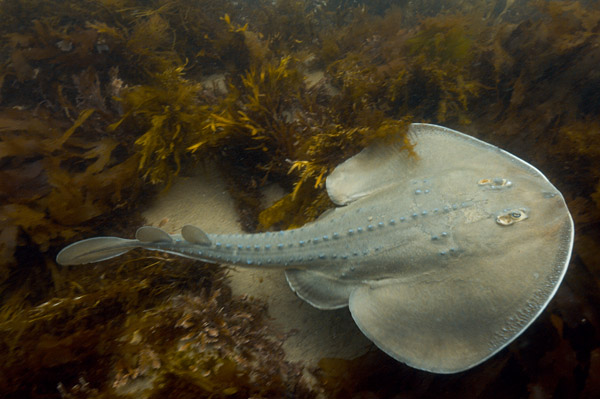|

View all available
Thornback Ray Pictures
Common
English Names: Thornback Ray, Thornback Guitarfish.
Latin
Name: Platyrhinoidis triseriata.
Family:
Platyrhinidae - containing 2 genera and 5 described species.
Thornback rays look superficially similar to guitarfishes but thy
are actually more closely related to stingrays.
Identification:
Rounded disc slightly wider than long
with rounded anterior edge which has a thin white margin. Three pronounced rows
of tubercles (spines) run along back and tail from behind eyes. Tail broad
with two well developed, rounded dorsal fins of roughly equal size set close to
caudal fin. Oval caudal fin small. Dorsum uniformly light brown to grey. Ventrum pale.
Two separate rostral cartilages extend from the skull to the tip of the snout
which differentiates thornback rays from guitarfishes which have only one.
Size:
Maximum
length 91cm.
Habitat:
Intertidal
inshore
waters to 50m. On sand and mud bottoms and occasionally in or around kelp beds.
Abundance
and distribution:
Central
California to Baja.
Behavior: During the
day lays
partially buried in sand. Forages for worms, molluscs and crustaceans in the
substrate. May be solitary or in groups.
Reproduction:
Thornback rays are ovoviviparous (yolk
sac viviparity). This species is said to be oviparous laying skate egg shaped cases but this needs
to be confirmed.
Conservation Status: The IUCN lists the
California Thornback Ray as LEAST CONCERN. However, although
the Thornback Ray is not targeted, it is known to be occasionally
caught in commercial and recreational fisheries in United States and
in Mexican waters. There is little information available on catches
in Mexico, but this species is likely to be taken by inshore
fisheries in lagoons on the Baja Pacific coast and probably by
shrimp trawls in the Gulf of California. Further information is
urgently required given the species' restricted range in Mexico.
Photographs:
Tajegis Beach, Santa Barbara, California.
Similar
species: There is only one thornback ray living in this region. The closest
sympatric species is the Banded Guitarfish
which is easily identifiable by its bold markings and longer, more shark-like
tail.
Reaction
to divers: Generally easy to approach with slow movements. I was able to
follow the photographed specimen for most of a dive as it slowly swam around the
reef.
Diving logistics: Apparently a common species in many bays in southern California but it is often
in turbid inshore water where photography is difficult. Try hunting in shallow
bays just beyond the surf line for the best chance at sightings.
Citation:
Lawson, J., Carlisle, A.B. &
Villavicencio-Garayzar, C.J. 2016. Platyrhinoidis triseriata.
The IUCN Red List of Threatened Species 2016: e.T60112A80673588.
http://dx.doi.org/10.2305/IUCN.UK.2016-2.RLTS.T60112A80673588.en.
Downloaded on 18 October 2017.
|






















